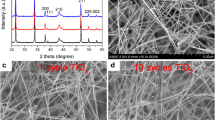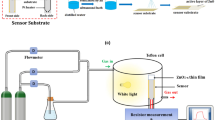Abstract
Nowadays an important task is the development of nanostructures of the Zn–Sn–O ternary oxide system, which are of practical interest for various fields, including gas sensors, photocatalysts, lithium-ion batteries, and solar cells. Zinc-stannate nanowires are formed by the hydrothermal treatment of preliminarily synthesized zinc-oxide nanowires in a solution of potassium stannate and carbamide. Using scanning electron microscopy and backscattered electron diffraction, the samples are found to have the Zn2SnO4 structure, and their geometric dimensions do not change compared to the initial zinc-oxide nanowires. The diameter of the obtained structures is about 300 nm, and the length is about 2 mm. According to X-ray photoelectron spectroscopy data, as a result of hydrothermal treatment, the surface structure changes and tin atoms are incorporated into the crystal structure of zinc oxide. The study of the gas-sensing properties of Zn2SnO4 layers shows that they are more efficient in detecting isopropyl alcohol vapor compared to the initial zinc-oxide nanowires. Zn2SnO4 layers allow the detection of isopropyl alcohol vapor at temperatures of about 150°C. The sensor signal with respect to 1000 ppm C3H7OH is 3.79.





Similar content being viewed by others
REFERENCES
B. F. Ormont, Introduction to Physical Chemistry and Crystal Chemistry of Semiconductors(Vysshaya Shkola, Moscow, 1982) [in Russian].
M. M. Sychev, T. S. Minakova, Yu. G. Slizhov, and O. A. Shilova, Acid-Base Characteristics of the Surface of Solids and Control of the Properties of Materials and Composites (Khimizdat, St. Petersburg, 2016) [in Russian].
A. P. Nechiporenko, Donor–Acceptor Properties of the Surface of Solid-Phase Systems: Indicator Method (Lan’, St. Petersburg, 2017) [in Russian].
I. Arora and P. Kumar, J. Alloys Compd. 845, 156316 (2020). https://doi.org/10.1016/j.jallcom.2020.156316
K. Deevi, V. K. Reddy, and I. Reddy, Mater. Lett. 283, 128848 (2021). https://doi.org/10.1016/j.matlet.2020.128848
P. Santhoshkumar, K. Prasanna, Y. N. Jo, S. H. Kang, Y. C. Joe, and C. W. Lee, Appl. Surf Sci. 449, 514 (2018). https://doi.org/10.1016/j.apsusc.2018.01.120
E. A. Levkevich, A. I. Maksimov, S. A. Kirillova, S. S. Nalimova, V. M. Kondrat’ev, and A. A. Semenova, in Proc. 2020 IEEE Conf. of Russian Young Researchers in Electrical and Electronic Engineering, EIConRus 2020 (St. Petersburg, 2020), p. 984. https://doi.org/10.1109/EIConRus49466.2020.9039451
S. Jain, A. P. Shah, and N. G. Shimpi, Nano-Struct. Nano-Objects 21, 100410 (2020). https://doi.org/10.1016/j.nanoso.2019.100410
S. S. Nalimova, A. I. Maksimov, L. B. Matyushkin, and V. A. Moshnikov, Glass Phys. Chem. 45, 251 (2019). https://doi.org/10.1134/S0132665119040097
P. P. Das, A. Roy, and P. S. Devi, Trans. Indian Ceram. Soc. 75, 147 (2016). https://doi.org/10.1080/0371750X.2016.1228482
N. H. Hanh, L. Van Duy, C. M. Hung, N. V. Duy, Y.-W. Heo, N. V. Hieu, and N. D. Hoa, Sens. Actuators, A 302, 111834 (2020). https://doi.org/10.1016/j.sna.2020.111834
C. Chen, G. Li, J. Li, and Y. Liu, Ceram. Int. 41, 1857 (2015). https://doi.org/10.1016/J.CERAMINT.2014.09.136
D. Wang, X. Pu, X. Yu, L. Bao, Y. Cheng, J. Xu, S. Han, Q. Ma, and X. Wang, J. Colloid Interface Sci. 608, 1074 (2022). https://doi.org/10.1016/j.jcis.2021.09.167
M. A. Anikina, A. A. Ryabko, S. S. Nalimova, and A. I. Maximov, J. Phys.: Conf. Ser. 1851, 012010 (2021). https://doi.org/10.1088/1742-6596/1851/1/012010
V. M. Kondratev, A. D. Bolshakov, and S. S. Nalimova, in Proc. 2021 IEEE Conf. of Russian Young Researchers in Electrical and Electronic Engineering, ElConRus 2021 (St. Petersburg, 2021), p. 1163. https://doi.org/10.1109/ElConRus51938.2021.9396573
A. A. Ryabko, A. I. Maximov, V. N. Verbitskii, V. S. Levitskii, V. A. Moshnikov, and E. I. Terukov, Semiconductors 54, 1496 (2020). https://doi.org/10.1134/S1063782620110238
A. Bobkov, A. Varezhnikov, I. Plugin, F. S. Fedorov, V. Goffman, V. Sysoev, V. Moshnikov, V. Trouillet, U. Geckle, and M. Sommer, Sensors 19, 4265 (2019). https://doi.org/10.3390/s19194265
S. S. Nalimova, Z. V. Shomakhov, K. N. Punegova, A. A. Ryabko, and A. I. Maksimov, Fiz.-Khim. Aspekty Izucheniya Klasterov, Nanostruktur Nanomater., No. 13, 910 (2021). https://doi.org/10.26456/pcascnn/2021.13.910
S. S. Nalimova, Z. V. Shomakhov, V. A. Moshnikov, A. A. Bobkov, A. A. Ryabko, and Z. Kh. Kalazhokov, Tech. Phys. 65, 1087 (2020). https://doi.org/10.1134/S1063784220070142
A. A. Ryabko, A. A. Bobkov, S. S. Nalimova, A. I. Maksimov, V. S. Levitskii, V. A. Moshnikov, ansd E. I. Terukov, Zh. Tekh. Fiz. 92, 758 (2022). https://doi.org/10.21883/JTF.2022.05.52382.314-21
S. S. Nalimova, A. A. Ryabko, A. I. Maximov, and V. A. Moshnikov, J. Phys.: Conf. Ser. 1697, 012128 (2020). https://doi.org/10.1088/1742-6596/1697/1/012128
S. S. Karpova, V. A. Moshnikov, A. I. Maksimov, S. V. Mjakin, and N. E. Kazantseva, Semiconductors 47, 1026 (2013). https://doi.org/10.1134/S1063782613080095
S. S. Nalimova, A. A. Bobkov, A. A. Ryabko, A. I. Maximov, V. A. Moshnikov, Z. V. Shomakhov, and Z. K. Kalazhokov, J. Phys.: Conf. Ser. 1658, 012034 (2020). https://doi.org/10.1088/1742-6596/1658/1/012034
S. Yan, Y. Yu, W. Zheng, and Y. Cao, Phys. E (Amsterdam, Neth.) 106, 57 (2019). https://doi.org/10.1016/j.physe.2018.10.011
S. Yan, Z. He, G. Zhou, Y. Yu, and T. Cao, Mater. Sci. Semicond. Process. 130, 105818 (2021). https://doi.org/10.1016/j.mssp.2021.105818
E. Wang, W. Yang, and Y. Cao, J. Phys. Chem. C 113, 20912 (2009). https://doi.org/10.1021/jp9041793
Funding
V.M. Kondratev is grateful to the Ministry of Science and Higher Education of the Russian Federation for the financial support (Agreement no. 075-03-2023-106 dated January 13, 2023, project FSMG-2021-0005).
Author information
Authors and Affiliations
Corresponding authors
Ethics declarations
The authors declare that they have no conflicts of interest.
Rights and permissions
About this article
Cite this article
Shomakhov, Z.V., Nalimova, S.S., Kondratev, V.M. et al. Changes in the Energy of Surface Adsorption Sites of ZnO Doped with Sn. J. Surf. Investig. 17, 898–902 (2023). https://doi.org/10.1134/S1027451023040316
Received:
Revised:
Accepted:
Published:
Issue Date:
DOI: https://doi.org/10.1134/S1027451023040316




